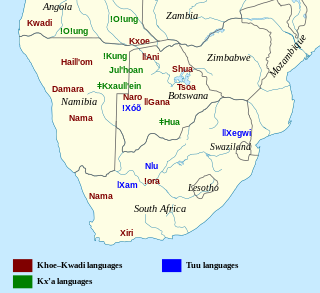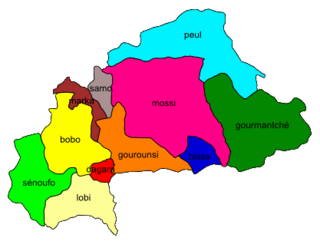Related Research Articles

TaaTAH, also known as ǃXóõKOH, is a Tuu language notable for its large number of phonemes, perhaps the largest in the world. It is also notable for having perhaps the heaviest functional load of click consonants, with one count finding that 82% of basic vocabulary items started with a click. Most speakers live in Botswana, but a few hundred live in Namibia. The people call themselves ǃXoon or ʼNǀohan, depending on the dialect they speak. The Tuu languages are one of the three traditional language families that make up the Khoisan languages. In 2011, there were around 2,500 speakers of Taa.

Sandawe is a language spoken by about 60,000 Sandawe people in the Dodoma Region of Tanzania. Sandawe's use of click consonants, a rare feature shared with only two other languages of East Africa – Hadza and Dahalo, had been the basis of its classification as a member of the defunct Khoisan family of Southern Africa since Albert Drexel in the 1920s. Recent investigations however suggest that Sandawe may be related to the Khoe family regardless of the validity of Khoisan as a whole. A discussion of Sandawe's linguistic classification can be found in Sands (1998).
Akan is a group of several closely related languages within the wider Central Tano languages. These languages are the principal native languages of the Akan people of Ghana, spoken over much of the southern half of Ghana. About 80% of Ghana's population can speak an Akan language as a first or second language, and about 44% of Ghanaians are native speakers. There are populations of polyglots in Ghana who speak an Akan language as a third language. They are also spoken in parts of Côte d'Ivoire.
Goemai is an Afro-Asiatic language spoken in the Great Muri Plains region of Plateau State in central Nigeria, between the Jos Plateau and Benue River. Goemai is also the name of the ethnic group of speakers of the Goemai language. The name 'Ankwe' has been used to refer to the people, especially in older literature and to outsiders. As of 2020, it is estimated that there are around 380,000 Goemai speakers.
Turkana is the language of the Turkana people of Kenya and Ethiopia. It is spoken in northwestern Kenya, primarily in Turkana County, which lies west of Lake Turkana. It is one of the Eastern Nilotic languages, and is closely related to Karamojong, Jie and Teso of Uganda, to Toposa spoken in the extreme southeast of South Sudan, and to Nyangatom in the South Sudan/Ethiopia Omo valley borderland; these languages together form the cluster of Ateker Languages.
Yakkha is a language spoken in parts of Nepal, Darjeeling district and Sikkim. The Yakkha-speaking villages are located to the East of the Arun river, in the southern part of the Sankhuwasabha district and in the northern part of the Dhankuta district of Nepal. About 14,000 people still speak the language, out of 17,003 ethnic Yakkha in Nepal. Genealogically, Yakkha belongs to the Eastern Kiranti languages and is in one subgroup with several Limbu languages, e.g. Belhare, Athpare, Chintang and Chulung. Ethnically however, the Yakkha people perceive themselves as distinct from the other Kiranti groups such as Limbu.
Dulong or Drung, Derung, Rawang, or Trung, is a Sino-Tibetan language in China. Dulong is closely related to the Rawang language of Myanmar (Burma). Although almost all ethnic Derung people speak the language to some degree, most are multilingual, also speaking Burmese, Lisu, and Mandarin Chinese except for a few very elderly people.
Sa or Saa language is an Austronesian language spoken in southern Pentecost Island, Vanuatu. It had an estimated 2,500 speakers in the year 2000.

The Tarahumara language is a Mexican Indigenous language of the Uto-Aztecan language family spoken by around 70,000 Tarahumara (Rarámuri/Ralámuli) people in the state of Chihuahua, according to a 2002 census conducted by the government of Mexico.

Dagaare is the language of the Dagaaba people of Ghana, Burkina Faso, and Ivory Coast. It has been described as a dialect continuum that also includes Waale and Birifor. Dagaare language varies in dialect stemming from other family languages including: Dagbane, Waale, Mabia, Gurene, Mampruli, Kusaal, Buli, Niger-Congo, and many other sub languages resulting in around 1.3 million Dagaare speakers. Throughout the regions of native Dagaare speakers the dialect comes from Northern, Central, Western, and Southern areas referring to the language differently. Burkina Faso refers to Dagaare as Dagara and Birifor to natives in the Republic of Côte d'Ivoire. The native tongue is still universally known as Dagaare. Amongst the different dialects, the standard for Dagaare is derived from the Central region's dialect. Southern Dagaare also stems from the Dagaare language and is known to be commonly spoken in Wa and Kaleo.
Like most other Niger–Congo languages, Sesotho is a tonal language, spoken with two basic tones, high (H) and low (L). The Sesotho grammatical tone system is rather complex and uses a large number of "sandhi" rules.

The Nukak language is a language of uncertain classification, perhaps part of the macrofamily Puinave-Maku. It is very closely related to Kakwa.
Izi is an Igboid language spoken in Ebonyi state in Nigeria. It forms a dialect cluster with the closely related languages Ikwo, Ezza, and Mgbo.
Shilluk is a language spoken by the Shilluk people of South Sudan. It is closely related to other Luo languages. The term Shilluk is a pronunciation of Arabic origin.
Mian is an Ok language spoken in the Telefomin district of the Sandaun province in Papua New Guinea by the Mian people. It has some 3,500 speakers spread across two dialects: West Mian, with approximately 1,000 speakers in around Yapsiei, and East Mian, with approximately 2,500 speakers in and around Timeilmin, Temsakmin, Sokamin, Gubil, Fiak and Hotmin.

Maʼya is an Austronesian language of the Raja Ampat islands in Southwest Papua, Indonesia. It is part of the South Halmahera–West New Guinea (SHWNG) subgroup and is spoken by about 6,000 people in coastal villages on the islands Misool, Salawati, and Waigeo, on the boundary between Austronesian and Papuan languages.
Moro is a Kordofanian language spoken in the Nuba Mountains of South Kordofan, Sudan. It is part of the Western group of West Central Heiban Kordofonian languages and belongs to the Niger-Congo phylum. In 1982 there were an estimated 30,000 Moro-speakers. This was before the second Sudan civil war and therefore the recent number of speakers might differ. There can be noted an influence of Arabic and it is suspected that today approximately a fourth of all Moro vocabulary has a relation or an origin in the Arabic language.

The Yukulta language, also spelt Yugulda, Yokula, Yukala, Jugula, and Jakula, and also known as Ganggalidda, is an extinct Tangkic language spoken in Queensland and Northern Territory, Australia. It was spoken by the Yukulta people, whose traditional lands lie on the southern coast of the Gulf of Carpentaria.
Bukiyip (Bukiyúp), or Mountain Arapesh, is an Arapesh language (Torricelli) spoken by around 16,000 people between Yangoru and Maprik in the East Sepik Province of Papua New Guinea. Bukiyip follows the SVO typology. The Arapesh languages are known for their complex noun-phrase agreement system.
Mixtepec Mixtec is a Mixtec language that is spoken in the lower Mixteca region. Mixtec language is largely spoken in the area of San Juan Mixtepec, district of Juxtlahuaca, state of Oaxaca. However, the language is also spoken in other areas including Tlaxiaco, San Quintín Baja California, Santa María California, and Oregon. In 2004, it was reported that approximately 12,000 people spoke the Mixtepec Mixtec language. While most speakers of the language refer to it as 'sa'an ntavi' meaning 'language of the poor' or 'poor people's language,' others refer to it as 'sa'an save' which means 'rain language.' It is not closely related to other varieties of Mixtec.
References
- ↑ Kumam at Ethnologue (22nd ed., 2019)

- ↑ Hammarström, Harald; Forkel, Robert; Haspelmath, Martin; Bank, Sebastian (2023-07-10). "Glottolog 4.8 - Southern Lwoo". Glottolog . Leipzig: Max Planck Institute for Evolutionary Anthropology. doi: 10.5281/zenodo.7398962 . Archived from the original on 2023-11-21. Retrieved 2023-11-20.
- 1 2 3 4 5 6 7 Hieda, Osamu (2020). "Kumam". The Oxford Handbook of African Languages: 611–629. doi:10.1093/oxfordhb/9780199609895.001.0001.
- ↑ "Kumam". Ethnologue. Retrieved 2020-09-28.